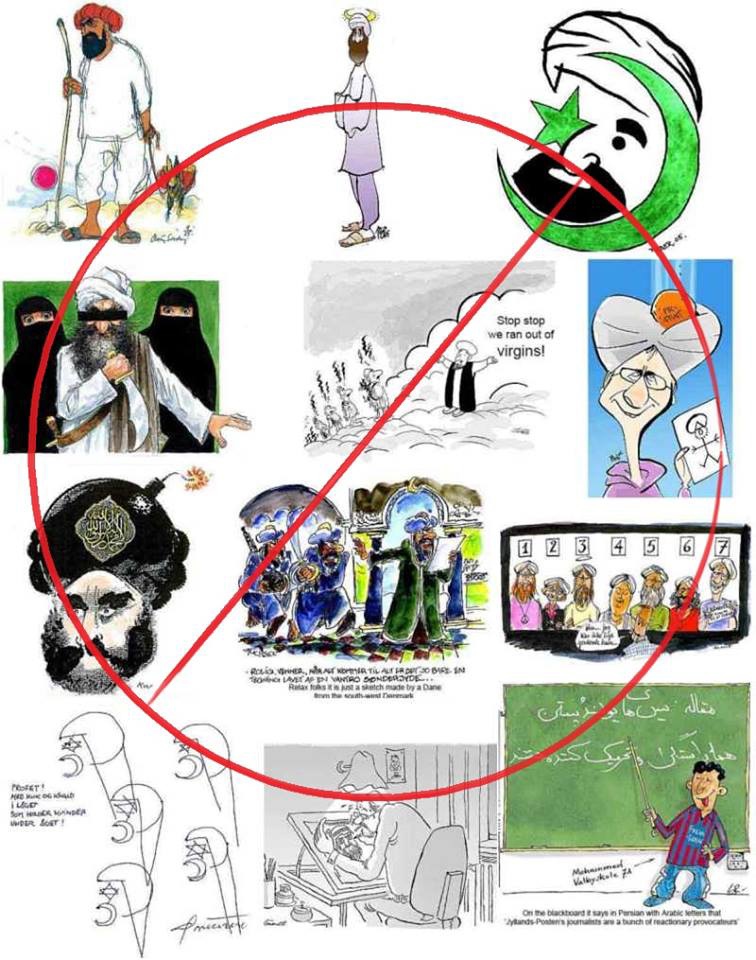
Before you try to find out who should be responsible for the catastrophe of Chile Hebdo Massacre, I humbly ask you could consider the Council of Europe Recommendation No. R (97) 20 (hereinafter R97) and the EU Council Framework Decision 2008/913/JHA on Combating Certain Forms and Expressions of Racism and Xenophobia by Means of Criminal Law.
According to the R97, its preambular elucidates the term of hate speech "shall be understood as covering all forms of expression which spread, incite, promote or justify racial hatred, xenophobia, anti-Semitism or other forms of hatred based on intolerance, including: intolerance expressed by aggressive nationalism and ethnocentrism, discrimination and hostility against minorities, migrants and people of immigrant origin."
Even if the religious factor is not clearly considered by the above catalog, the “Spirit of Islam” in some sense shall be acknowledged it has the essence of “minority” when in comparison with the main religion in Europe. Meantime, the Principle 6 and 7 advise the media’s and its professional’s responsibilities when “contributing to their dissemination as part of their mission to communicate information and ideas on matters of public interest.”
Although the media reports on racism, xenophobia, anti-Semitism or other forms of intolerance although is fully protected by Article 10(1) of the European Convention on Human Rights, it may only be interfered with under the conditions set out in paragraph 2 of that provision. Also, the national authorities shall consider the restriction for the freedom of expression whether or not in accordance with the criteria established by the case law of the Convention's organs, inter alia, to the “manner, content, context and purpose of the reporting.”
Unlike news or report, satirical cartoons may reveal the feeling of the editor after he/ she observes the current events among the world. Yet, it may not be considered that satirical cartoons enjoy the looser standard of hate speech than news or report. Satirical cartoons may make fun for its readers, but in some sense could be assault or disrespect to what these cartoons indicate.
Furthermore, the EU Council Framework Decision also indicates that each Member State shall take the measures necessary to ensure that the intentional conduct while “publicly inciting to violence or hatred directed against a group of persons or a member of such a group defined by reference to race, colour, religion, descent or national or ethnic origin” is punishable. The Decision goes further, regulates the situation to publicly incite to violence or hatred directed against religion and prohibits the commission of an act referred to the mentioned situation by “public dissemination or distribution of tracts, pictures or other material.”
Besides, according to the Report from the Commission to the European Parliament and the Council on the implementation of the Decision, after the 1 December of 2014 the Commission have the powers to launch infringement proceedings under Article 258 TFEU with regard to Framework Decisions adopted prior to the entry into force of the Treaty of Lisbon. In other words, Member State may confront the dilemma between the EU Commission if its criminal law could not correspond with the Decision.
Apart from the foreseeable conflicts between EU and its Member State, if we could perceive the history of blasphemy law and admit the term “blasphemy” is not the proper noun to either Catholic or Christianity but to all religions, it could be infer that the EU takes serious concern into account whether the religion could be qualified as one object of hate speech. Someone may argue the necessity of either blasphemy law or hate speech law and yell for “full” freedom of speech or expression, this kind of assertion would be very much selfish because “tolerance” is not only meaningful to the hearers but also the speakers. In other words, speakers ask hearers to tolerate his/ her ability of having a speech, and vise versa.
Moreover, under the European Convention on Human Rights, Article 10 paragraph 1 and 2 regulate the ambit of freedom of speech or expression as well. In my viewpoint, although it is not easy for legislators to erect fences to protect the minorities and not to cause so-called “chilling effect” for freedom of speech or expression, the criteria should be consider some factors such as the intention of speaker, the area of forging unpleasant expression and the scale of impact by biased content at least.


 留言列表
留言列表
